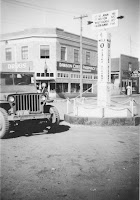 |
| Mile "0" 1947 |
Driving non-interstate highways in the lower 48 I often see the little green mile post signs beside the road with a number indicating how many miles I am from somewhere. But I rarely pay much attention to them. Up north it’s different. With the great expanses of land and long distances between communities, the mile posts provide important gauges to locate points of interest.
Perhaps it all started with the Alaska Highway. Starting at mile 0, in Dawson City, B. C, points along the way were identified by mile posts, ending with mile post 1422 in Delta Junction, Alaska. For example, a certain bridge might be located at mile post 330 and so on. It gave the road builders a point of reference and the mile post concept stuck.
 |
| Early copy of Milepost |
 |
| Current Milepost |
The old dog sled routes might have used the same system, with less precision.
Now mile posts are a way of life; an address system where no addresses exist. They are in use on all the major roads (and there aren’t that many) in Alaska. A town will be located at mile post 440. A gas station at mile post 665, and so on.
 |
| Delta Junction, End of the Road |
Travelers in Alaska often carry the bible of Alaska travelers, The Milepost. An annual publication in its 65th printing it chronicles all the major roads, mile by mile, listing services and sights to see along the way. When gas stations, for example, are widely spaced, The Milepost can provide guidance for fill up. With nearly 800 pages it is packed with facts, can be used as a door stop and, if you are trapped in the wild, makes an excellent fire starter.
After three weeks on the road, ours is beginning to show its age but it’s still serviceable and, with its guidance, we haven’t needed to start any fires.
In basic science class we learned that objects expand when hot and shrink when cold (aka, the shrinkage factor.) Water is an exception. It expands when frozen. That is bad news for road builders of the north when the water in question is beneath a road. The result is a “frost heave” or big bump in the road.
Winter plays havoc on roads in the north and no place more than the road from Beaver Creek to Haines Junction in the Yukon Territory. The ice forces the road up, breaking the asphalt and making driving a challenge. It seems that, after 70 years, they still haven’t solved the "heave" problem on the Alcan. Mother Nature is a clever girl.
When the ground is still frozen they can’t make repairs so the best the road crew can do is place fluorescent flags on little stakes where the damage is the worst. When you see those flags, caution is advised, particularly if you are pulling a small trailer. Getting “air” with a camp trailer is not a good thing.
Friday: Tok to Haines Junction
 |
| click to enlarge |


No comments:
Post a Comment